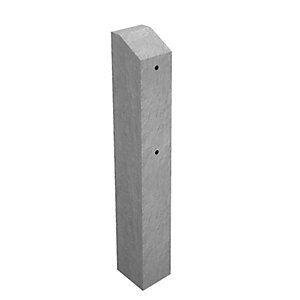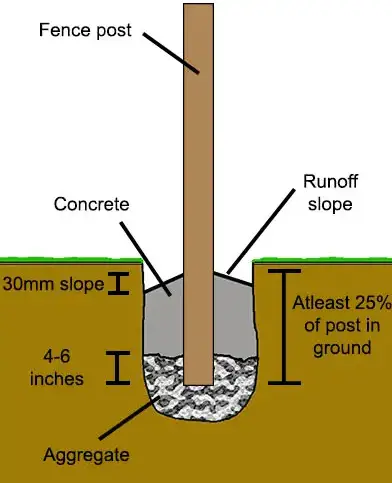Setting the fence posts is an excellent opportunity to get things in your hands since this project is straightforward, and more homeowners can do it themselves. Here is a reminder that people can do this project without having a piece of profound knowledge. But at some point, knowing the facts and rules is still essential before you start it.
Since it will not harm anyone but benefit you, the concrete you will apply should take 20 to 40 minutes to become solid and dry before you can start making another layer or step as you wish to design the concrete fence post.

Still, it is not a complete statement that working on concrete will take you to the completion of the project, and letting it dry in specified hours will be the final duration. The edges and corners would likely take longer or shorter than a limited time.
Many people in this state are concerned about the drying of concrete and what you need to know about the drying time and how long it will stay.
Knowing about the drying time is nearly half the real thing, and all you need to know is the complete procedure of how long it could stay and what time with which material is appropriate.
Before digging, remember to know the frost line for the fence post.
What is concrete curing?
Curing is the process of providing adequate moisture, temperature, and time for the concrete, which allows it to reach its desired strength.
Curing is also considered an exothermic reaction between the two elements, water and cement. Let us define cement property here: cement is one of three elements. All three are cement, sand, and aggregate. Cement plays its role as a binding agent; as discussed above, this element has the property to bind all materials and let them stay in their place so they can’t fall apart.
This could end up in the way of cracking dusting of material (surface), or even it could collapse. So this is the critical factor if you have prepared a surface or a wall of concrete, let it stay wet and moist, or at least you must seal the wall with another layer of coating of different material so the moisture in the concrete would not be lost.

Here is a tip you need to understand on the first note t: Howry your solid is because the soil is the first thing that will contact the concrete turned into your fence post.
The reason behind the soil is that it absorbs the water from the concrete right after you pour it, and gradually, you will see the dry results of the concrete in your fence post. For this, you need to put extra effort into making it wet for quite a time so that it will remain intact. This is just for the case if your soil is dry, but contrary to it, if the soil of your backyard is not dry and still in its prime t, you do not need to worry about it so much. Since the water content is already in the soil will help the concrete o remain wet and stay strong. The curing process will be ongoing automatically; you do not have to put in the extra effort.
In this case, you can stay at ease and seal the concrete surface if you think or see dryness in the concrete, which causes further water content loss from the concrete.
Different situations and conditions can affect the concrete, such as weather conditions or any other cases that might occur.
How Long Does Concrete Take to Dry for Fence Posts?
Concrete takes around 24 hours to dry for fence posts; afterward, applying weight to the post is safe. However, the cure time is seven days during dry weather above 50 F; during freezing weather, you must wait up to 28 days.
Theoretically, you can apply some weight to the posts after only 4 hours because concrete sets in 20 to 40 minutes and has adequate strength after 4 hours.
Concrete typically takes 24-48 hours to dry enough for fence post installation. However, the exact drying time can vary depending on several factors, such as the weather conditions, the type of concrete used, and the size and depth of the hole.
In general, waiting at least 24 hours before attaching any weight or pressure to the post is recommended, such as adding fence panels or hanging gates. If the weather is hot and dry, the concrete may dry faster, but the drying time may be longer if it’s cold or damp.
It’s important to note that while the concrete may be dry enough to support weight after 24-48 hours, it may take several days or even weeks to cure and fully reach its maximum strength. During this time, it’s essential to avoid putting excessive weight or pressure on the post and exposing it to freezing temperatures, which can cause the concrete to crack or break.
Fence post concrete cure time
Here is a list of estimated fence post concrete cure times based on temperature and moisture levels:
- Dry weather, temperatures above 50°F (10°C):
- Initial set time: 4-6 hours
- Final set time: 24 hours
- Cure time: 7 days
- Mild weather, temperatures between 40-50°F (4-10°C):
- Initial set time: 6-8 hours
- Final set time: 48 hours
- Cure time: 14 days
- Cold weather, temperatures between 30-40°F (-1 to 4°C):
- Initial set time: 8-12 hours
- Final set time: 72 hours
- Cure time: 21 days
- Freezing weather, temperatures below 30°F (-1°C):
- Initial set time: 12-24 hours
- Final set time: 96 hours
- Cure time: 28 days
It’s important to note that these times are only estimates and can vary depending on the specific type of concrete used, the hole’s depth and size, and the soil’s moisture levels. Generally, it’s best to follow the manufacturer’s instructions and consider the weather conditions when planning a fence post-installation.
How long does it take for concrete to dry?
Concrete takes 28 days to dry entirely and gain full, adequate strength. However, it takes 24 to 48 hours to dry partially and gain enough strength to walk on it.
The Cold Weather and Concrete
So, the first condition is cold weather. The cold temperature can dry the concrete, and the curing process will eventually stop. So, for the concrete to remain in its better position, the temperature outside must not be below the specific degree, which is 50 Fahrenheit, which is 10 degrees Celsius. The concrete in the fence post needs to be in the curing process so that it can be vital, and for that, the temperature must be moderate, so you have to be careful not to do this concrete project in freezing weather.
If you need it urgently and the temperature goes down after the day you have completed the concrete fence post-project, or on the contrary side, the temperature suddenly drops. If you forgot to check the weather forecast, don’t panic! Just watch that your fence post does not get the immediate effect during the chilly weather, and if it starts, you can do it for the temperature to go every day, and then you can see the curing process will start taking its place.
Many people recommend that you build the fence post near your home or at least near the electricity to save your fence post concrete project; in this way, you can keep the fence post dry and warm in cold weather. However, let me add one thing: It would be costly. So, I would recommend waiting for the cold weather to pass.
Warm temperature and concrete.
The longer the concrete stays in the curing process, the weaker its strength. The curing process speeds up, and the higher the temperature, the faster the concrete cures.
Temperature is an essential role-playing element in the curing process; if your concrete does not have a suitable temperature, it will not become a hard, rocky concrete fence post and will be dry and weak during the curing process.
Now comes the mix; the mix is the type of concrete, which means concrete is being mixed with other elements. This type of concrete needs to be taken care of more appropriately since it can affect the amount of time that it usually takes to dry and for you to start the other step.
So here is some advice: using weak or mixed material will not guarantee that your fence posts will not fall on their own or because of natural factors, but spending a little money on concrete will at least allow you to stay assured that they will not fall.
The concrete may take some time to dry and some effort to complete its curing process, but in the end, it provides you with complete and satisfying results. On the contrary, pour the mixed sandy material into the ground base for the fence posts.
Fence post benefits
The primary purpose of the fence posts is to stay firm and stand for a longer period, whereas they have to bear heavy winds and rains. So, the fence posts are meant to be strong and can prevail over the boundary. However, instead of strength, the material used in the fence posts should be robust and durable; otherwise, the fence posts can not stay stable any longer.
However, this is the opposite of the fact that using concrete in the fence posts’ ground base can give your fence posts a long life and strength. And on the other side, if you still want to go for the different cheap material, that would still cost you enough.
Your fence post will stay on the weak material, and you know that will put you under the continuous threat of the fence post falling. The reason could be anything, like animals, wind storms, or any other factor.
The fact is that the fence posts will take a reasonable period to cure, and that is just for their curing process; if this takes place at a specific time, then the fence post will be sound and will stay in its place with steady form, but this all depends on the work and efforts you put in it.





